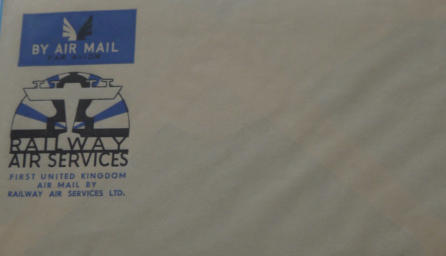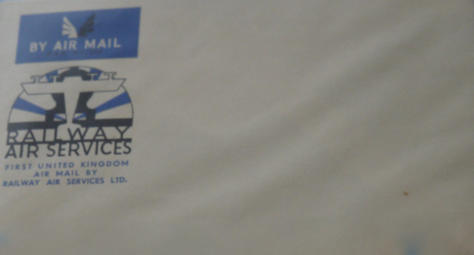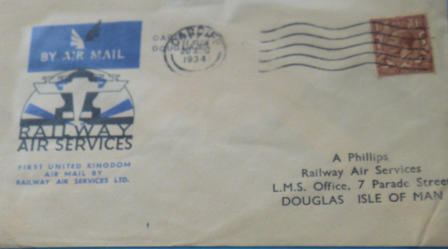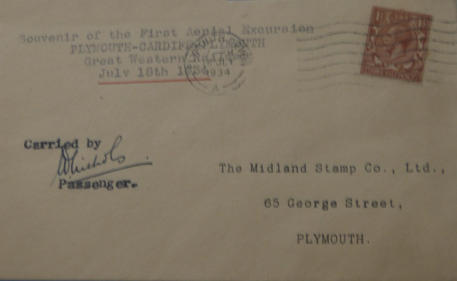
Railway Air Services - Introduction
By a long way the largest and most important airline of the 1930’s was Railway Air Services. Despite its importance it has had
little attention from writers, the one book written on the RAS by John Stroud in 1987 only gave pages 30 - 66 for information
about RAS in the thirties, so effectively for our purposes it is a 36 page book. The most important question to ask at the
beginning is ‘what was the RAS?’ Essentially it acted as an administrator and co-ordinator of Airlines run by its constituent
railways. It passed all the money it took to the railways that ran the services and then charged the cost of its services to the
Railways. At the start it was obvious where it all fitted but as the 1930’s went on, RAS invested in parts of airlines and had
interests in airlines which did not come under the RAS livery. In the end it really was not clear what the RAS role was as it split
tis ownership but kept its name on timetables and in the public perception. For this reason, I concentrate on the early years
where its role was clear. In the 1930’s there were 4 main Railways in competition. These were the railways that made up RAS,
Great Western Railway (GWR), London, Midland and Scottish (LMS), London North Eastern Railway (LNER) and Southern
Railways (SR). But most importantly there was a non-Railways silent partner in Imperial Airways. Partnering with Imperial
AIrways (IA) made perfect sense. The Railways could compete with IA in Europe and if it so wished IA could compete internally
with the Railways. By forming one group they prevented unnecessary competition and allowed IA to fly to Europe and the
Railways to stay in Britain. IA agreed to supply everything to do with flying, aircraft, pilots, airfields etc, whilst RAS did the
admin, the marketing, selling the tickets etc. The board of RAS represented these five interests with each Railway providing a
member and Imperial Airways providing the 5th.
In the early thirties the four main railways were considering how to deal with air travel and did studies on the subject. Three of
the four main railways decided to go into flying, whilst LNER considered a London-Norwich-Hull-Newcastle-Edinburgh-
Aberdeen service but eventually passed it over. Each railway had a specific route for which it was responsible along with IA.
GWR continued its route of the previous year from Birmingham to Plymouth. LMS took the route from Glasgow to London and
SR took the route from Liverpool to Cowes. RAS co-ordinated these routes to ensure that timetables gave maximum co-
ordination for onward travel so passengers and mail could quickly and efficiently get to all parts of the network not just the
stops on a specific route. One thing to remember is that the airlines operated in a different manner to today. Today swapping
flights is a tedious process sometimes taking hours. In the 1930’s turnover on internal flights was very quick, sometimes
scheduled at only 5 minutes. Enough time to get passengers and baggage off and on along with any freight or mail. It was rare
for turnover times to be more than twenty minutes. One of the things that complicates a study of the RAS is that they did not
just use IA, sometimes they sub-contracted their operations. So Spartan AIrways were contracted by SR and Manx Airways by
LMS. The timetables would show RAS in conjunction with Spartan or Manx. There were also sub-contractors for Belfast-Isle of
Man-Manchester and for Bristol to Cardiff. It is important to note that this was a town to town service. If the letter were
addressed outside the town catchment it would be sent by rail, not by air. Also, not all destinations were flown as logistically it
was unviable to go by air e.g. Liverpool to Belfast, Plymouth to Cowes. The RAS sections is split into sub sections, with each
destination represented.
Of particular interest in the study of RAS are the timetables. The timetables for the 20th were as follows
Railway Air Services Timetable for the 20th.
GLASGOW-LONDON A.M. P.M Glasgow (Renfrew) dep 9.15 arr 7.30 Belfast (Aldergrove) arr 10.05 dep 6.40 dep. 10.25 arr 6.20 Manchester (Barton) arr 11.55 dep 4.50 A.M. P.M. dep 12.10 arr 4.35 Birmingham (Castle Bromwich) arr 12.40 dep 4.05 London (Croydon) arr 1.35 dep 3.10 ISLE OF MAN SHUTTLE SERVICE A.M. P.M. Belfast (Aldergrove) dep. 10.07 arr 6.30 I.O.M. (Ronaldsway) arr. 10.57 dep 5.37 Manchester (Barton) arr. noon dep 4.37 . LIVERPOOL-PLYMOUTH Liverpool Airport dep 8.45 arr 7.45 Birmingham (Castle Bromwich) arr 9.30 dep 7.00 Cardiff Airport arr 10.45 dep 5.55 Haldon (for Teignmouth) arr 11.30 dep 3.00 dep 11.35 arr 4.55 Plymouth (Roborough) arr 11.55 dep 4.35 BIRMINGHAM-COWES A.M. P.M. A.M. P.M. Birmingham (Castle Bromwich) d. 9.35 2.15 a 2.00 6.55 Bristol Airport a 10.30 3.10 d. 1.05 6.00 Southampton Airport a. 11.15 3-55 d 12.20 5.15 d. 11.20 4.00 a. 12.15 5.10 Cowes (Somerton) a. 11.30 4.10 d. 12.05 5.00 CARDIFF TO BRISTOL (mail-carrying service only) A.M. P.M. Cardiff Airport dep. 10.05 12.35 Bristol Airport arr. 10.20 12.50
Copyright
© 2022 Robert Farquharson All Rights Reserved
The first RAS route to open was the Spartan Airways line on May 1st from London (Heston) to Cowes with request stops at Ryde and Bembridge. On
May 7th the old GWR route of Plymouth to Birmingham opened. On the 30th July, the Birmingham to Cowes line opened and finally on the first day of
the air mail contract the Glasgow to London route opened. There are covers which were carried on the GWR route with 3d railway stamps although I
have not seen any,
Souvenir Mail
Printers Errors
To finish off this section a couple of examples of what Redgrove described as printers waste but are interesting. The first is caused by the black being omitted. The second is caused by the colours becoming misaligned by the black moving up 3.5mm. This shows most clearly by the blue appearing on the wings on the plane.
On the July 18th a souvenir flight was flown, and various pieces of souvenir mail were flown.
The official souvenir covers were printed on two types of paper, rough and smooth, although I do not think collectors attach much importance to this.
These are mint examples of the two types. There is a suggestion there may be a third type of printing. This is discussed in the article by Martin Czech
titled ‘More than two printings of the Railway Air Services official covers.’



British Internal Airmails of the 1930’s

Missing black colour Teignmouth to Liverpool


Missing black colour Teignmouth to Liverpool

Missing black colour Teignmouth to Liverpool




Railway Air Services - Introduction
By a long way the largest and most important airline of the 1930’s was Railway Air Services. Despite its importance it has had
little attention from writers, the one book written on the RAS by John Stroud in 1987 only gave pages 30 - 66 for information
about RAS in the thirties, so effectively for our purposes it is a 36 page book. The most important question to ask at the
beginning is ‘what was the RAS?’ Essentially it acted as an administrator and co-ordinator of Airlines run by its constituent
railways. It passed all the money it took to the railways that ran the services and then charged the cost of its services to the
Railways. At the start it was obvious where it all fitted but as the 1930’s went on, RAS invested in parts of airlines and had
interests in airlines which did not come under the RAS livery. In the end it really was not clear what the RAS role was as it split
tis ownership but kept its name on timetables and in the public perception. For this reason, I concentrate on the early years
where its role was clear. In the 1930’s there were 4 main Railways in competition. These were the railways that made up RAS,
Great Western Railway (GWR), London, Midland and Scottish (LMS), London North Eastern Railway (LNER) and Southern
Railways (SR). But most importantly there was a non-Railways silent partner in Imperial Airways. Partnering with Imperial
AIrways (IA) made perfect sense. The Railways could compete with IA in Europe and if it so wished IA could compete internally
with the Railways. By forming one group they prevented unnecessary competition and allowed IA to fly to Europe and the
Railways to stay in Britain. IA agreed to supply everything to do with flying, aircraft, pilots, airfields etc, whilst RAS did the
admin, the marketing, selling the tickets etc. The board of RAS represented these five interests with each Railway providing a
member and Imperial Airways providing the 5th.
In the early thirties the four main railways were considering how to deal with air travel and did studies on the subject. Three of
the four main railways decided to go into flying, whilst LNER considered a London-Norwich-Hull-Newcastle-Edinburgh-
Aberdeen service but eventually passed it over. Each railway had a specific route for which it was responsible along with IA.
GWR continued its route of the previous year from Birmingham to Plymouth. LMS took the route from Glasgow to London and
SR took the route from Liverpool to Cowes. RAS co-ordinated these routes to ensure that timetables gave maximum co-
ordination for onward travel so passengers and mail could quickly and efficiently get to all parts of the network not just the
stops on a specific route. One thing to remember is that the airlines operated in a different manner to today. Today swapping
flights is a tedious process sometimes taking hours. In the 1930’s turnover on internal flights was very quick, sometimes
scheduled at only 5 minutes. Enough time to get passengers and baggage off and on along with any freight or mail. It was rare
for turnover times to be more than twenty minutes. One of the things that complicates a study of the RAS is that they did not
just use IA, sometimes they sub-contracted their operations. So Spartan AIrways were contracted by SR and Manx Airways by
LMS. The timetables would show RAS in conjunction with Spartan or Manx. There were also sub-contractors for Belfast-Isle of
Man-Manchester and for Bristol to Cardiff. It is important to note that this was a town to town service. If the letter were
addressed outside the town catchment it would be sent by rail, not by air. Also, not all destinations were flown as logistically it
was unviable to go by air e.g. Liverpool to Belfast, Plymouth to Cowes. The RAS sections is split into sub sections, with each
destination represented.
Of particular interest in the study of RAS are the timetables. The timetables for the 20th were as follows
Railway Air Services Timetable for the 20th.
GLASGOW-LONDON A.M. P.M Glasgow (Renfrew) dep 9.15 arr 7.30 Belfast (Aldergrove) arr 10.05 dep 6.40 dep. 10.25 arr 6.20 Manchester (Barton) arr 11.55 dep 4.50 A.M. P.M. dep 12.10 arr 4.35 Birmingham (Castle Bromwich) arr 12.40 dep 4.05 London (Croydon) arr 1.35 dep 3.10 ISLE OF MAN SHUTTLE SERVICE A.M. P.M. Belfast (Aldergrove) dep. 10.07 arr 6.30 I.O.M. (Ronaldsway) arr. 10.57 dep 5.37 Manchester (Barton) arr. noon dep 4.37 . LIVERPOOL-PLYMOUTH Liverpool Airport dep 8.45 arr 7.45 Birmingham (Castle Bromwich) arr 9.30 dep 7.00 Cardiff Airport arr 10.45 dep 5.55 Haldon (for Teignmouth) arr 11.30 dep 3.00 dep 11.35 arr 4.55 Plymouth (Roborough) arr 11.55 dep 4.35 BIRMINGHAM-COWES A.M. P.M. A.M. P.M. Birmingham (Castle Bromwich) d. 9.35 2.15 a 2.00 6.55 Bristol Airport a 10.30 3.10 d. 1.05 6.00 Southampton Airport a. 11.15 3-55 d 12.20 5.15 d. 11.20 4.00 a. 12.15 5.10 Cowes (Somerton) a. 11.30 4.10 d. 12.05 5.00 CARDIFF TO BRISTOL (mail-carrying service only) A.M. P.M. Cardiff Airport dep. 10.05 12.35 Bristol Airport arr. 10.20 12.50
Copyright
© 2020 Robert Farquharson All Rights Reserved
The first RAS route to open was the Spartan Airways line on May 1st from London (Heston) to Cowes with request stops at Ryde and Bembridge. On
May 7th the old GWR route of Plymouth to Birmingham opened. On the 30th July, the Birmingham to Cowes line opened and finally on the first day of
the air mail contract the Glasgow to London route opened. There are covers which were carried on the GWR route with 3d railway stamps although I
have not seen any,
Souvenir Mail
Printers Errors
To finish off this section a couple of examples of what Redgrove described as printers waste but are interesting. The first is caused by the black being omitted. The second is caused by the colours becoming misaligned by the black moving up 3.5mm. This shows most clearly by the blue appearing on the wings on the plane.
On the July 18th a souvenir flight was flown, and various pieces of souvenir mail were flown.
The official souvenir covers were printed on two types of paper, rough and smooth, although I do not think collectors attach much importance to this.
These are mint examples of the two types. There is a suggestion there may be a third type of printing. This is discussed in the article by Martin Czech
titled ‘More than two printings of the Railway Air Services official covers.’



British Internal Airmails of the 1930’s

Missing black colour Teignmouth to Liverpool


Missing black colour Teignmouth to Liverpool

Missing black colour Teignmouth to Liverpool























































































